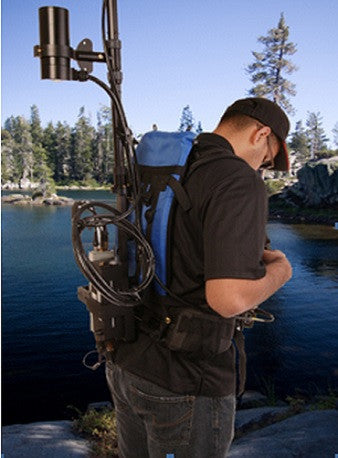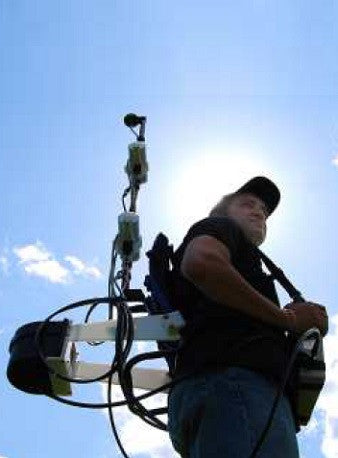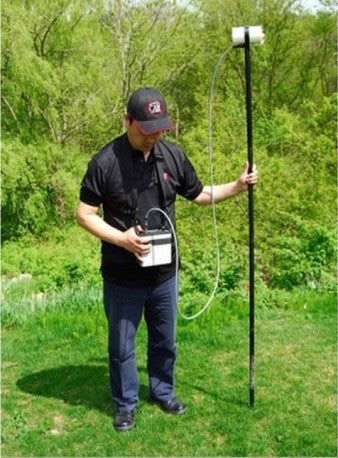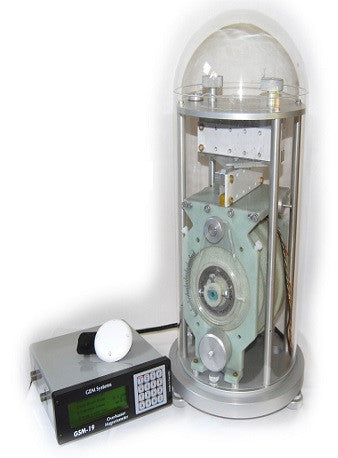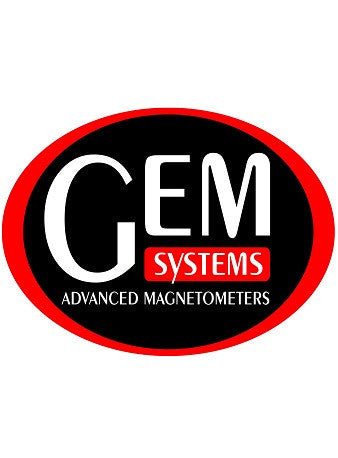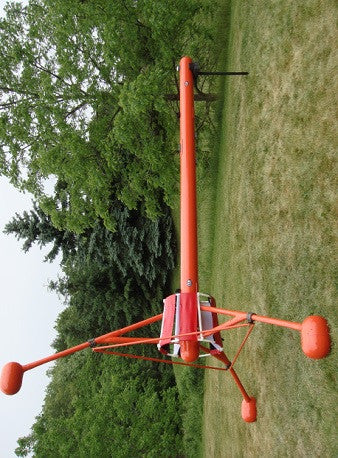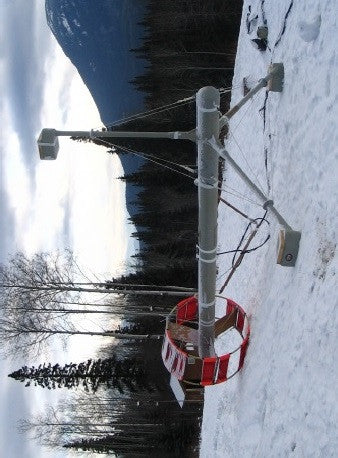Proton Precession Magnetormeter - GSM-19T
Supplied By: GEM Systems, Canada
Rs. 0.00
Introduction - Proton Precession Magnetormeter
GEM’s advanced Proton Precession magnetometer (GSM-19T) is one of the world’s leading instruments for subsurface investigations and exploration. The Proton system is designed to fit the niche for clients who require a low-cost, yet versatile magnetometer for ground geophysical surveys. This system is an entry-level system for clients who require an advanced system without the higher-order features and benefits of GEM’s Overhauser and Potassium systems.
The GSM-19T Proton Precession unit is a unique product only available from GEM. It features highly-effective proton energization and physics, three data acquisition modes (Walking – optional, Mobile and Base Station); has a large-volume on-board storage and memory; and comes complete with a high-resolution (0.6 m) integrated GPS – one of the first magnetometers in the world to offer this time-saving, effective technology.
This proven system offers a range of benefits for different applications. In mineral exploration, the GSM-19T has shown itself to be a mainstay of many programs – offering robustness for a demanding environment around the world. In oil and gas exploration, the GSM-19T offers similar benefits. It is also an effective tool in environmental and engineering work for detection of buried drums, utilities and other man-fabricated buried objects.
From robust field units to efficient survey modes and fast data downloading, the GSM-19T is designed to deliver the maximum value in a proton precession system. It also provides numerous technologies that differentiate it from other systems, including robust design, no heading errors and other features.
Version 7.0 Upgrades
With v7.0 upgrades, GEM’s system leads the competition in sensitivity, memory, base station technology and other areas. The rover unit now features a 25% increase in sensitivity – reflecting new processing algorithms and addition of the latest RISC microprocessors.
In addition, v7.0 standard memory is 32 Mbytes (expandable in 32 Mb increments), which translates into 1,465,623 readings of line / station data or more than 5,373,951 readings for base station mode. The new memory capacity sets an industry standard, but more importantly, it means that operators can now handle even the largest surveys with ease.
Proton Precession Magnetometer Applications
The Proton Precession instrument is the total field magnetometer/gradiometer of choice for customers who require:
-
Integrated navigation with GPS
-
A fraction of an nT sensitivity
-
Minimal heading error
-
Ease of operation
-
Classic affordability
-
32 MB Memory
-
Most up-to-date Proton Precession technology available
Selected customers prefer GEM’s Proton Precession systems for use in:
-
Academic and teaching
-
Environmental and engineering
-
Magnetic observatory measurements (limited use)
-
Mineral exploration (ground work and airborne base station)
-
Observatory (older installations)
-
Pipeline mapping
Specifications
Performance
-
Sensitivity: 0.15 nT @ 1 reading per sec/0.05 nT @ 1 reading every 4 sec.
-
Resolution: 0.01 nT
-
Absolute Accuracy: +/- 0.2 nT @ 1 Hz
-
Dynamic Range: 20,000 to 120,000 nT
-
Gradient Tolerance: over 7000 nT/m
-
Samples at: 60+, 5, 4, 3, 2, 1, 0.5 sec
-
Operating Temperature: -40°C to 50°C
Operating Modes
-
Manual: coordinates, time, date and reading stored automatically at minimum 3 sec. interval
-
Base Station: time, date and reading stored at 3 to 60 second intervals
-
Remote Control: optional remote control using RS-232 interface
-
Input/Output: RS-232 or analog (optional) output using 6-pin weatherproof connector
Storage - 32MB (# of Readings)
-
Mobile: 1,465,623
-
Base Station: 5,373,951
-
Gradiometer: 1,240,142
-
Walking Mag: 2,686,975
Dimensions & Weight
-
Console: 223 x 69 x 240 mm; 2.1Kg
-
Sensor: 170 x 71mm diameter cylinder; 2.2Kg (Including Staff Assembly)
Standard Components
-
GSM-19T console
-
GEMLinkW software
-
Batteries
-
Harness
-
Charger
-
Sensor with cable
-
RS-232 cable
-
USB adapter, staff
-
Instruction manual and shipping case
Optional VLF
-
Frequency Range: Up to 3 stations between 15 to 30.0 kHz
-
Parameters: Vertical in-phase and out-of-phase components as % of total field. 2 relative components of the horizontal field.
-
Resolution:0.1% of total field

Features and Benefits
The new v7.0 system is the industry’s latest innovation in proton precession magnetometers with many new technologies that deliver significant benefits for earth science applications.
Key Technologies Include:
-
Data export in standard XYZ format for easy use in standard commercial software programs
-
Programmable export format for full control over output
-
GPS elevation values values provide input for geophysical modelling
-
Standard GPS Option B: 1 SBAS (WAAS, EGNOS, MSAS)
-
High Resolution GPS Option D
-
0.6m SBAS (WAAS, EGNOS, MSAS)
-
0.6 CDGPS(Canada, USA, Mexico)
-
0.6 OmniStar(VBS2 subscription)
-
-
Multi-sensor capability and VLF-EM option for advanced surveys to resolve target geometry
-
Picket and line marking/annotation for capturing related surveying information on the go
Main Benefits of GEM's Precession Technology:
-
0.05 nT sensitivity: The company’s proton precession solution provides a broad sensitivity range suitable for finding ferrous buried objects.
-
Minimal heading error: Similar to the Overhauser method, Proton Precession devices are not affected by the heading errors. With Proton Precession, the signals being measured are from one relatively well-defined spectral line, hence, heading errors are minimized naturally.
-
Ease of operation: GEM’s Proton Precession magnetometers/gradiometers are widely adopted, readily understood technologies.
-
Cost effectiveness: GEM’s pricing reflects the desire to satisfy its customers who require a magnetometer/gradiometer system with a high-quality entry-level instrumentation package. As noted below, GEM’s v7.0 system also offers customers the same set of functionality as in the GSM-19 Overhauser as a built-in value.
-
Latest technology: GEM continues to add new functionality to its products and the Proton Precession system is an example of this process and results. The system has all v6.0 features, including GPS functionality and lane guidance; Internet upgrades for firmware replacement without shipping systems back; and spike suppression algorithms.
Designed from the Ground Up
Leading the list of advances is GEM’s rover unit which features a 25% increase in sensitivity - reflecting new processing algorithms and implementation of the latest RISC microprocessors.
In addition, v7.0 standard memory is 32 Mbytes (expandable in 32 Mb increments), which translates into 1,465,623 readings of line / station data or more than 5,373,951 readings for base station units.
The new memory capacity sets an industry standard, but more importantly, it means that operators can now handle even the largest surveys with ease.
Another important innovation is GEM’s unique programmable base station which you can enable via either a field unit or a Personal Computer as follows:
-
Daily scheduling (define working hours and minutes each day). This mode provides economy of memory and battery usage on a daily basis.
-
Flexible scheduling (up to 30 on / off periods). Simply define a series of intervals and the base station will turn itself on as you need. This mode provides the greatest flexibility for longer surveys where leaving your base station running increases efficiency.
-
Immediate start. This mode is the traditional mode of starting a base station unit and leaving it until the operator can return to turn off the unit
Survey Planning and Efficiency
One of the traditional challenges in ground surveys is ensuring that surveys are designed and implemented effectively.
With the v7.0 proton precession system, GEM addresses this challenge through standard GEM capabilities: the Walking Mag option that enables the operator to sample while walking. Having nearly continous data on survey lines also helps to increase the accuracy of interpretations.
Another innovation is GPS way point pre-programming. You can define a complete survey in the office on your PC and download this information directly to a rover unit via RS-232. The operator performs the survey using the points as survey guide with a resulting decrease in er-rors and more rapid survey completion.
Survey Operations
The GSM-19T helps the operator on a daily basis while performing surveys. A key feature is the easy-to-read LCD data display in graphical (or text) format with a signal quality indicator to determine when readings need to be repeated.
GEM’s proton precession unit is very tolerant to gradients and provides a warning indicator: the operator can monitor data quality continuously. Other features include easy-to-use line and station incrementing together with the end-of-line indicators.
Fast Data Transfer
Another traditional area in which time is lost in surveys is in data transfer. In v7.0, GEM addressed this in several ways:
-
Data download is tripled to 115 KBaud (fastest rate possible with RS-232).
-
PC-based data reduction is possible using an upgraded version of GEMLinkW, GEM’s proprietary data transfer software.
GPS and Other Software
GEM Systems recently became the only manufacturer to provide a fully integrated GPS option for its line of proton precession products. Along with metre to submetre positioning options, the new processing functionality enables users to take advantage of the benefits of GPS.
Some of the capabilities include:
-
Preprogramming of way points. Postprocessing of GPS data. GEM’s DGPS op-tion enables transfer of GPS data for post-processing and merging via 3rd party software
-
Precise time synchronization of field and base station units. This capability is particularly important for working in noisy magnetic conditions and provides the highest accuracy possible
-
In addition to its own software, GEM is also pleased to offer a variety of data analysis and processing software from 3rd party developers
Integrated GPS is a huge development. Led by GEM, the GSM-19T has been at the forefront of GPS technology innovation. This gives highly accurate time for base station corrections as well as other capabilities such as Waypoint Programming.
With Waypoints, you design your survey on your personal computer and import the stations with ease into the magnetometer console. Then, the system will guide you to each Waypoint where a reading is to be made. With Walking mode, you have a nearly continuous record of GPS-referenced datapoints – a major advantage in surveying because you save time in the field and it eliminates the possibility of measuring at an incorrect station – you always know the station toward which you are headed next. Other key features are the easy-to-read LCD data display in graphical (or text) format with a signal quality indicator. The unit is tolerant to gradients and provides a warning indicator: the operator can monitor data quality continuously.
Ongoing Maintenance and Support
As a potential user of a GSM-19T system - the industry’s end-to-end solution - you should also know that we stand by our technologies, products and services.
With 30 years of success and new innovations in magnetics plus Internet-based upgrades that keep your system up-to-date and ongoing support, GEM offers the best solution in proton precession units today.
The Walking Magnetometer / VLF
Historically, Proton Precession instruments have tended to be operated in a standalone mode in which the operator must stand at a known station and press a button to record a reading. This slows down surveys considerably and increases costs. However, GEM developed the world’s first, “Walking Mag” system that deals with these issues.
The Walking Proton Precession magnetometer / gradiometer is a unique implementation of electronics and physics to provide a nearly continuous record of the ground over which the instrument is carried. GEM offers up to 0.5 second sampling to accommodate surveys at a walking pace.
With the Walking mode, clients are assured of the highest productivity that can be obtained with this type of magnetometer – GEM has advanced the limits of this technology to almost its absolute maximum through its knowledgeable research and development team.
Walking mode also enables the use of GEM’s new Walking VLF. VLF or Very Low Frequency surveying is an electromagnetic method used for shallow exploration (up to 35 m or so). GEM’s Walking VLF enables magnetic measurements to be made along with a single channel of VLF data.
Related Products




